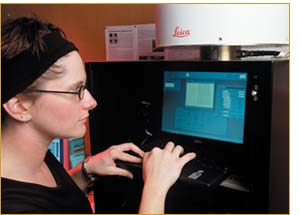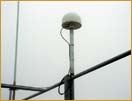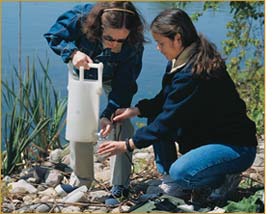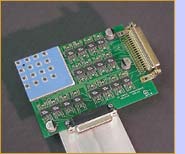

Although not a new concept, network embedded systems are being used in novel ways in a variety of research initiatives. From civil structures and defense systems to environmental and health monitoring, networked embedded systems represent the next generation in computing, communications, and technologies, where individual sensors react to, communicate with, organize, and maintain themselves in relationship to each other, to the entire system, and to the environment in which the system is placed. “There are two very important notions about embedded systems,” says Panos J. Antsaklis, the H.C. and E.A. Brosey Professor of Electrical Engineering. “Most obvious is the fact that they are embedded. You cannot access an embedded system and change its programming as easily as you could that of a computer. As important is that the mission of these little computers -- because that’s what a microprocessor is, and embedded systems are made up of microprocessors -- is not to ‘compute.’ It is to improve the function of the device in which it is embedded.” Perhaps the most widely publicized embedded system in consumer products today is the OnStar® service, which is available in a variety of new cars, trucks, and recreational vehicles. OnStar tracks vehicles and assists drivers as needed in real time, providing services such as air bag deployment notification, roadside assistance, stolen vehicle tracking, remote door unlock, and remote diagnostics. But it is just one example of an embedded system. Embedded systems are prevalent in households around the world. Washing machines, dryers, microwaves, and cell phones all feature embedded systems. They were developed by engineers who embraced the change that has been steadily progressing since Jack Kilby and Robert Noyce first introduced the microchip in the early 1960s. In essence OnStar and other embedded systems take a microprocessor, originally used to analyze data or interact with a desktop user according to a series of commands, and instead program it to interact with the real world. The benefits of using embedded systems in consumer products are obvious; they raise the quality of life by making products more functional and more efficient. Equally as positive are the benefits derived when embedded systems technology is applied to a variety of research projects, such as the work being accomplished at the University of Notre Dame. Following Lowell’s analogy, faculty in the College of Engineering are not “putting on their overcoats” in an effort to shield themselves from the change but to embrace it. Donning their boots and hats and running headlong into the “east wind,” they are leading the way in developing network embedded systems for research in disciplines not previously employing this type of sophisticated technology.  For example,
as part of a National Science Foundation study, Ahsan
Kareem, the Robert Moran Professor of Civil Engineering and Geological
Sciences, and Rooney Family Assistant Professor Tracy
Kijewski-Correa are using networked embedded devices to monitor
the structural performance of several tall buildings in Chicago. They
are working with Skidmore, Owings & Merrill LLP (SOM), one of the
world’s premier architecture and engineering firms and the company
responsible for the design of structures such as the Sears Tower, the
Lever House in New York City, and the Bank of America World Headquarters
in San Francisco. Another partner in the study is the Boundary Layer
Wind Tunnel Laboratory of the University of Western Ontario, a world
leader in commercial wind tunnel testing. For example,
as part of a National Science Foundation study, Ahsan
Kareem, the Robert Moran Professor of Civil Engineering and Geological
Sciences, and Rooney Family Assistant Professor Tracy
Kijewski-Correa are using networked embedded devices to monitor
the structural performance of several tall buildings in Chicago. They
are working with Skidmore, Owings & Merrill LLP (SOM), one of the
world’s premier architecture and engineering firms and the company
responsible for the design of structures such as the Sears Tower, the
Lever House in New York City, and the Bank of America World Headquarters
in San Francisco. Another partner in the study is the Boundary Layer
Wind Tunnel Laboratory of the University of Western Ontario, a world
leader in commercial wind tunnel testing.“We’ve been interested in how wind affects the performance of tall buildings for several years,” says Kareem. “This particular study focuses on some of the signature structures in the world, which were designed and built at a time when scale-model testing and computer modeling were not as advanced as they are today. We want to determine if the structures are behaving in the manner for which they were designed.” Questions Kareem and the research team, known as Team Chicago, are asking include: Were the procedures used at the time of the structures’ design representative of realistic loadings and response? Are the structures performing as expected? And, if they are not, how does that impact design criteria for the next generation of urban structures? Modeling technologies have changed over the years, but cityscapes have also changed. The urban landscape of Chicago, for instance, is much more developed than it was a few decades ago, when buildings like the Sears Tower and the Aon (Amoco) Building were designed. Thus, the wind travels through cities and buffets buildings in a much different manner than it did in the early 1970s.  Kareem
and Kijewski-Correa are using traditional monitoring devices, such as anemometers
and accelerometers, in conjunction with cutting-edge technology such as the Leica
MC500 Global Positioning System (GPS) with Real Time Kinematic potential. Four
accelerometers have been mounted in pairs in opposite corners on the highest
floor of each building in the study. This positioning enables detection of a
building’s motion along its two lateral perpendicular axes, as well as
twisting movements. Kareem
and Kijewski-Correa are using traditional monitoring devices, such as anemometers
and accelerometers, in conjunction with cutting-edge technology such as the Leica
MC500 Global Positioning System (GPS) with Real Time Kinematic potential. Four
accelerometers have been mounted in pairs in opposite corners on the highest
floor of each building in the study. This positioning enables detection of a
building’s motion along its two lateral perpendicular axes, as well as
twisting movements.“We use high-precision servo-force balance accelerometers,” says Kijewski-Correa, “because these buildings move at very low amplitudes and with long periods. It’s not like measuring a seismic event, where you see much larger levels of motion.” According to Kareem, stand-alone implementation of this technology does not provide sufficient accuracy to monitor building displacements as indicators of performance. In order to make corrections for atmospheric conditions that affect the GPS signal, he and Kijewski-Correa use a low-rise structure in the city as a base station. This differential monitoring reduces errors to as little as five millimeters. Using this measurement protocol, the Notre Dame team can monitor a building’s movements every one-tenth of a second. (A real-time feed of the data can also be used by owners in the daily management of the buildings in the study, including the operation of elevator systems and skydecks.) “What’s important to remember is that even before we installed the hardware and began collecting data, we spent two years calibrating the equipment in relation to the GPS system,” says Kareem. “Because of this, we are very confident in our data.” Information from the sensors is transmitted to a communications hub in the SOM building in Chicago and then relayed, via the Ethernet, to Notre Dame, where it is archived in a web-assisted database and analyzed. Scale models of the structures and the surrounding built environment are then developed in the Boundary Layer Wind Tunnel to compare the predicted response to full-scale data. “In essence we’re tracking the vital signs of individual structures in order to give us a better indication of in-situ building performance,” says Kijewski-Correa. “By using conventional and advanced sensors, Notre Dame is taking the lead in the integrated monitoring of tall structures. We are not designing the sensors themselves, but we have adapted and prototyped a networked configuration of these devices for capturing signals peculiar to long-period civil structures. Our findings could directly impact the architectural and structural communities for years to come. |
||
|
||
| According to Martin
Haenggi, assistant professor of electrical engineering, networked
embedded systems can also be placed in natural environments, enabling
researchers to observe any kind of habitat at the scale and in the
amount of detail that has never before been possible. Haenggi and a
team of researchers from throughout the College of Engineering are
developing an embedded sensor network for monitoring the hydrology
and ecology of freshwater lakes and streams, the Naiades project. Named for the nymphs of rivers, lakes, and streams of Greek mythology, Naiades represents what will be a five-year collaborative effort between researchers in the Department of Electrical Engineering and the University’s Center for Environmental Science and Technology (CEST), including team leaders Patricia A. Maurice, professor of civil engineering and geological sciences and director of CEST, and Michael D. Lemmon, associate professor of electrical engineering. Other faculty currently involved in the project are Antsaklis; Haenggi; Sharon Hu, associate professor of computer science and engineering; J. Nicholas Laneman,assistant professor of electrical engineering, Agnes E. Ostafin, assistant professor of chemical and biomolecular engineering; Jeffrey W. Talley, assistant professor of civil engineering and geological sciences; and George Hornberger, the Ernest H. Ern Professor of Environmental Sciences at the University of Virginia. “The Naiades project,” says Maurice, “has the potential of greatly enhancing our knowledge of the hydrologic cycle, water quality, pollution, the potential effects of microorganisms, and even biological warfare. It’s an innovative solution to building better environmental models so we can better understand our world and what impacts it.” Current technology dictates that a researcher seeking to understand the physicochemical reactions that occur in a lake or stream has to either collect samples -- physically go to the lake or stream, gather water, and take it back to a lab for testing -- or set up a commercial sensor in the water to record variables in things like pH or conductivity. The trouble has been that the real world involves a variety of spatial and temporal scales not addressed by these testing methods. Although researchers gather samples under a variety of conditions, they do not normally collect data during sub-zero temperatures or thunderstorms. In addition, even the most accurate commercial sensors have been limited in the number of samples or amount of information they could record or process.  Naiades will
differ from current technologies in two very important ways. First, the system
will be an internet of control area networks connected through wireless gateways
that link simple sensors -- measuring things like temperature, conductivity,
turbidity, flow, and ambient light -- to bacterial sensors and bulk water samplers,
which will measure major cations, anions, metals, and pesticides. Secondly, the
system will feature underwater nodes and surface base stations, each with an
embedded computer. The wireless ad hoc network formed by the base stations, the
Naiades subnet, will be able to automatically reconfigure routing pathways based
upon the local analysis performed by the sensors, individually and collectively. Naiades will
differ from current technologies in two very important ways. First, the system
will be an internet of control area networks connected through wireless gateways
that link simple sensors -- measuring things like temperature, conductivity,
turbidity, flow, and ambient light -- to bacterial sensors and bulk water samplers,
which will measure major cations, anions, metals, and pesticides. Secondly, the
system will feature underwater nodes and surface base stations, each with an
embedded computer. The wireless ad hoc network formed by the base stations, the
Naiades subnet, will be able to automatically reconfigure routing pathways based
upon the local analysis performed by the sensors, individually and collectively. Information gathered by the system could be used for immediate needs, such as issuing alerts to the appropriate agencies of increased E. coli levels in beach areas or for long-term research projects. Field tests, scheduled to begin in year three of the project, will focus on detecting, forecasting, and monitoring storm events and diel (day/night) fluctuations. The Naiades project also includes several educational objectives. A learning module will be developed for the University’s first-year engineering course sequence. Information from the project will also be incorporated into the curriculum of CE 498/598: Introduction to Environmental Engineering and Science and a graduate course on water-rock interactions. Graduate students involved in the project will participate in a one-credit-hour interdisciplinary special topics course to be taught by project faculty. And, an interdisciplinary workshop on environmental sensors will be held on campus during the final year of the project. Perhaps one of the most attractive elements of this interdisciplinary effort is that researchers will not have to travel far to find a natural laboratory in which to test the system they are creating. The Naiades system will first be tested in the two lakes on campus, St. Mary’s and St. Joseph’s, in order to develop accurate predictive models of algal blooms, an important environmental question that would benefit from the high-resolution, real-time data collection offered via the Naiades system. |
||
|
||
| Unfortunately, the solution
-- using embedded systems to better monitor the real world -- is not
as straightforward as it seems. “Embedded processors and their
proliferate use, such as the development of the Naiades project,” says
Antsaklis, “is driven by the fact that we are able to cheaply manufacture
these devices. But, you cannot simply set out a group of processors and
expect them to act together in a coherent fashion in relationship to
the real world. It simply will not happen without a tremendous amount
of planning and a detailed
understanding of hybrid dynamical systems.” According to Antsaklis, when a system is distributed, so is the information. No single node contains all the information, and no single node acts as the command center. “The traditional notions of communications are challenged,” he says. “One of the first considerations in a network is to establish a path along which the nodes communicate. In addition, there is a lot of protocol software that needs to be written or refined to ensure that the processors are synchronized with one another and with the real world. And, finally, because they are out in the real world ... some of them miles away from a power source ... they need to be able to operate on small batteries or solar power.” These are some of the issues being addressed by the Naiades team. When they are successful in developing these intelligent sensors and flexible embedded systems, they will have made a quantum leap in environmental monitoring. This knowledge can then be applied to defense systems, to health monitoring, to the coordination of satellites or traffic systems ... the list is endless. But, the change is inevitable. The novel ways University researchers are employing networked embedded systems to collect data will usher in improvements to the way skyscrapers are designed, aircraft are built, and the environment is monitored. These changes may not inspire a 21st-century Sandburg or Thoreau to wax eloquent about the nodes, motes, or actuators, but the changes which will be implemented from the information gained will help build a better world. For more information on networked embedded systems technology and research in the College of Engineering, visit: Center for Environmental Science and Technology http://www.nd.edu/~cest/ Department of Aerospace and Mechanical Engineering http://www.nd.edu/~ame/ Department of Electrical Engineering http://xml.ee.nd.edu NATHAZ Modeling Laboratory http://www.nd.edu/~nathaz/ http://windycity.ce.nd.edu/ |
 Aero-optics is the study of the interaction of light with a turbulent
flow. The light could emanate from distant space objects or celestial
bodies, or it could be a laser beam. In general, the interaction
of these optical signals with turbulent air has a degrading effect,
which is why stars appear to twinkle. This effect is particularly
devastating to the quality of a laser beam projected from an aircraft,
where the thin layer of turbulent air surrounding an aircraft can
reduce the focus of a laser on a distant target to less than 1
percent of its intensity.
Aero-optics is the study of the interaction of light with a turbulent
flow. The light could emanate from distant space objects or celestial
bodies, or it could be a laser beam. In general, the interaction
of these optical signals with turbulent air has a degrading effect,
which is why stars appear to twinkle. This effect is particularly
devastating to the quality of a laser beam projected from an aircraft,
where the thin layer of turbulent air surrounding an aircraft can
reduce the focus of a laser on a distant target to less than 1
percent of its intensity.